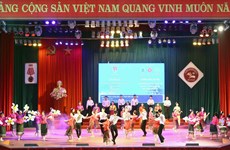Bamboo, rattan sector calls for capital, technology to develop
Though Vietnam's bamboo and rattan sector has the potential for
development, the sector is still facing challenges including capital,
raw materials and technology the Communist Party of Vietnam Online
Newspaper reported.
Though Vietnam's bamboo and rattan sector has the potential for
development, the sector is still facing challenges including capital,
raw materials and technology the Communist Party of Vietnam Online
Newspaper reported.
According to the Agro-Forestry-Aquatic Product Trading, Processing and Salt Industry Department and Vietnam Association of Craft Villages (Vicrafts), poor strategic planning in domestic handicraft sector, backward technology and poorly designed products made the sector difficult to develop. The remarks were made at a seminar on Vietnam’s bamboo and rattan trade held by the Ministry of Agriculture and Rural Development in Hanoi in early April.
Luu Duy Dan, Chairman of Vicrafts, said that the whole country has 713 bamboo and rattan craft villages, which account for 24 percent of the total craft villages and attract approximately 350,000 employees. Since 2009, famous bamboo and rattan villages such as Phu Nghia, Chuong conical hat village, the Vac village, Chang Son and Phu Tuc of Hanoi have met difficulties due to unstable market conditions and stagnant production.
Craftsman Ta Thu Huong from the Chuong conical hat village in the Thanh Oai district of Hanoi, said that previously high-qualified conical hats were sold at least 120,000 VND each, but now the price has dropped to 50,000 VND. She noted that the price of raw materials is rising, causing more difficulties for production establishments.
So far, Vietnam has hundreds of businesses and thousands of employees who participate in processing bamboo and rattan products. However, the biggest difficulty of the businesses today is instable consumption.
According to the Vicrafts, 80 percent of the production establishments do not have sufficent capital to expand their production scale and invest in technological innovations.
According to Nguyen Manh Dung from the Agro-Forestry-Aquatic Product Trading, Processing and Salt Industry Department, to stabilise and expand the market of these products, the craft villages need to quickly change traditional processing techniques.
According to forecasts, demands of the raw material of craft villages will require at least one billion bamboo trees per year by 2020. To meet this demand, the country needs to plant about 60,000 hectares of bamboo and invest in wild bamboo conservation.
In the future, the State must have plan to develop bamboo and rattan areas to supply for the industry.
Additionally, the Government should provide financial support for enterprises and households as well as promote new market strategies for rattan and bamboo products. In particular, enterprises and villages should conduct market researches and register intellectual property rights in order to protect their brand names.-VNA
According to the Agro-Forestry-Aquatic Product Trading, Processing and Salt Industry Department and Vietnam Association of Craft Villages (Vicrafts), poor strategic planning in domestic handicraft sector, backward technology and poorly designed products made the sector difficult to develop. The remarks were made at a seminar on Vietnam’s bamboo and rattan trade held by the Ministry of Agriculture and Rural Development in Hanoi in early April.
Luu Duy Dan, Chairman of Vicrafts, said that the whole country has 713 bamboo and rattan craft villages, which account for 24 percent of the total craft villages and attract approximately 350,000 employees. Since 2009, famous bamboo and rattan villages such as Phu Nghia, Chuong conical hat village, the Vac village, Chang Son and Phu Tuc of Hanoi have met difficulties due to unstable market conditions and stagnant production.
Craftsman Ta Thu Huong from the Chuong conical hat village in the Thanh Oai district of Hanoi, said that previously high-qualified conical hats were sold at least 120,000 VND each, but now the price has dropped to 50,000 VND. She noted that the price of raw materials is rising, causing more difficulties for production establishments.
So far, Vietnam has hundreds of businesses and thousands of employees who participate in processing bamboo and rattan products. However, the biggest difficulty of the businesses today is instable consumption.
According to the Vicrafts, 80 percent of the production establishments do not have sufficent capital to expand their production scale and invest in technological innovations.
According to Nguyen Manh Dung from the Agro-Forestry-Aquatic Product Trading, Processing and Salt Industry Department, to stabilise and expand the market of these products, the craft villages need to quickly change traditional processing techniques.
According to forecasts, demands of the raw material of craft villages will require at least one billion bamboo trees per year by 2020. To meet this demand, the country needs to plant about 60,000 hectares of bamboo and invest in wild bamboo conservation.
In the future, the State must have plan to develop bamboo and rattan areas to supply for the industry.
Additionally, the Government should provide financial support for enterprises and households as well as promote new market strategies for rattan and bamboo products. In particular, enterprises and villages should conduct market researches and register intellectual property rights in order to protect their brand names.-VNA













